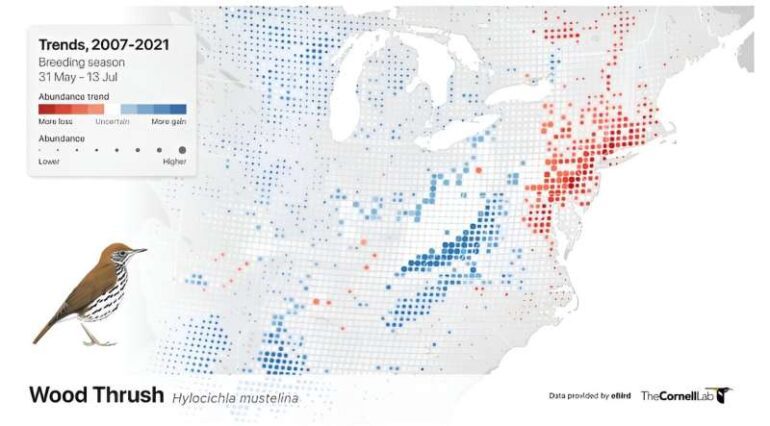TL;DR:
- Cornell Lab of Ornithology pioneers method for tracking population trends of 500+ bird species.
- The novel technique addresses statistical challenges posed by changing human behavior in data collection.
- Double Machine Learning identifies patterns in bird observation data, resulting in precise trend maps.
- Approach reveals authentic population fluctuations by removing confounding factors.
- Potential to enhance local conservation efforts and bridge data gaps in citizen science.
Main AI News:
In a pioneering stride, researchers at the esteemed Cornell Lab of Ornithology have introduced an ingenious mechanism to extrapolate the trajectories of over 500 bird species, discerning whether their populations are experiencing growth or decline. This inventive methodology rectifies a longstanding statistical conundrum by meticulously factoring in year-to-year shifts in the conduct of data-gathering enthusiasts. The outcome is a meticulously-detailed panorama of trends for each avian variety, narrowing down to an impressively minute eight-mile radius – a momentous stride bolstering localized conservation endeavors. This groundbreaking approach, known as Double Machine Learning, not only dissolves a perplexing statistical hurdle but also promises to revolutionize the realm of environmental preservation.
Daniel Fink, the leading author at the Cornell Lab, elaborates, “The dynamic nature of human behavior poses a formidable challenge in scrutinizing data sourced from volunteers. For instance, is the decline of a specific species authentic within a certain locale? Or could it be attributed to a diminished number of observers frequenting the bird’s preferred habitat, as compared to yesteryears?” This predicament unfurls when birding practices undergo shifts due to the integration of new technologies, enhanced bird identification skills, or the exploration of novel birding territories. The transformation in human behavior metamorphoses into what experts term a “confounding” element, exerting an influence on the core issue under exploration and potentially distorting reality itself. In this intricate web, fluctuations in documented bird populations could either signify genuine shifts or mere illusions, stemming from alterations in the observational procedures across temporal expanses.
Embarking on the wings of Double Machine Learning, the Cornell Lab harnesses the colossal dataset amassed by its global eBird initiative, subsequently transmuting it into visually elaborate maps. This sophisticated approach entails the acquisition of two distinctive patterns within the data fabric: firstly, the spectrum of fluctuations in reported bird counts, and secondly, the spectrum depicting fluctuations in birdwatchers’ behavior. Through the extraction of the behavior-related pattern, the subsequent analysis meticulously eliminates its influence, ultimately laying bare the genuine fluctuations in the recorded avian populace.
Delineating the significance of this breakthrough, Fink affirms, “At present, we hold the means to dissect this data labyrinth, thereby yielding resolute evaluations of population dynamics – a feat attainable even for species or locales devoid of stringent monitoring protocols. The capability to fathom trends, coupled with the adept navigation of confounding variables intrinsic to citizen science data, possesses the latent potential to bridge vital chasms in our understanding.”
Conclusion:
The breakthrough Double Machine Learning technique developed by the Cornell Lab of Ornithology holds immense promise for the avian conservation market. By accurately deciphering population trends and eliminating confounding variables, this innovation empowers conservationists with actionable insights, potentially steering resource allocation and initiatives for a more effective and targeted preservation strategy. The market stands to benefit from a heightened capacity to harness data-driven solutions, catalyzing smarter conservation decisions and fortifying the delicate balance of our ecosystems.

